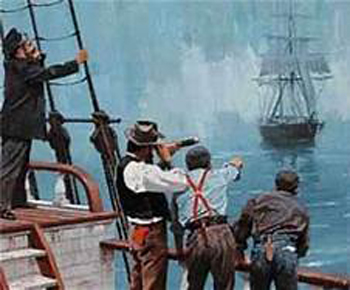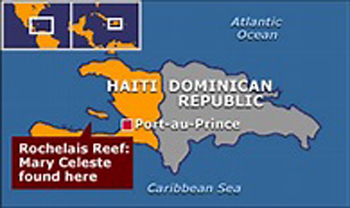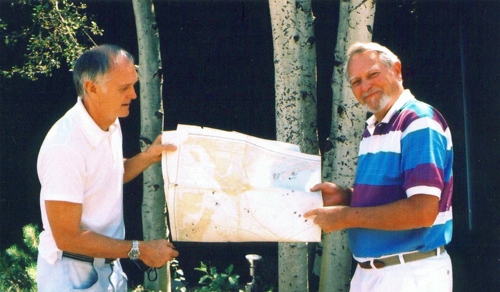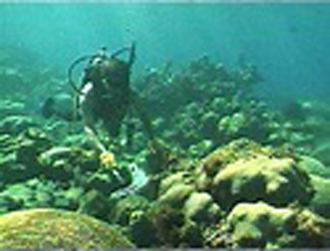Cussler is Ghost Buster in Discovery of Mary Celeste
When author/adventurer Clive Cussler found the remains of the Mary Celeste, he closed a chapter in the mystery of a “ghost ship” left floundering aimlessly in the mid-Atlantic more than a century ago. The second chapter, revealing what happened to the captain, his family and crew, has yet to be written. Cussler found the wreckage, but the unsolved mystery of the 282-ton seaworthy brigantine still whets the appetites of maritime sleuths throughout the world.

The Del Gratia crew spots the ghost ship Credit: Atlantic Mutual Insurance Co. Painting by G. Johnson
According to records kept by the Atlantic Mutual Insurance Company, the Mary Celeste left New York on November 7, 1872, bound for Genoa, Italy, with 1,700 barrels of alcohol in the hold. When discovered, the vessel had passed the last of the Azore Islands with about 600 miles remaining on its 3,000 mile voyage.
Theories about the mystery floated around for years (pun intended). They ranged from mutiny and murder to the sudden appearance of a phantom island rising from the depths, luring all aboard ship to their death. A more plausible account blamed a climatic change and leaking cargo as the culprits. The vessel, having sailed away from the cold New York temps, entered the toasty domain of the Azores where atmospheric changes affected the cargo. Upon opening the hatches to the unventilated hold, uprising fumes from the barrels of alcohol—some of which may have leaked—alarmed the crew. Captain Briggs, fearing for the safety of his two-year-old daughter, wife and crew, may have ordered the long boat to be lowered and joined to the brig by a tow rope. The plan was to return to the ship when the fumes subsided. But heavy seas could have parted the tow line, separating the long boat from the mother vessel in visibility which was rapidly deteriorating. Meteorological reports for the afternoon on that date showed gale force winds prevailing over this part of the Azores.

Map shows location of the Mary Celeste Credit: NUMA

Clive Cussler shows Ellsworth Boyd how he uses coordinates to locate shipwrecks Credit: Cathy Boyd
Clive Cussler and his National Underwater and Marine Agency (NUMA) have discovered 75 shipwrecks, many of which appeared in his novels. With help from the late Bob Fleming, a renowned researcher, Cussler obtained the coordinates of the wreck site. Accompanied by John Davis and three of his photographers from Eco Productions, Nova Scotia, Canada, the intrepid author boarded the 54-foot steel hull research vessel Ella Warley II owned and operated by Alan Gardner of Highland Beach, Florida. The team picked him up at Labadee Beach on the north shore and headed straight for Rochelais Reef.

Diver searches Rochelais Reef for the wreck’s remains Credit: NUMA
Although there was final closure in determining the fate of the ship, the question of what actually happened aboard the Mary Celeste still remains a mystery. As Cussler so aptly put it, “She’s enshrined as the most famous ghost ship in the history of the sea.”
Author: Ellsworth Boyd
Ellsworth Boyd, Professor Emeritus, College of Education, Towson University, Towson, Maryland, pursues an avocation of diving and writing. He has published articles and photo’s in every major dive magazine in the US., Canada, and half a dozen foreign countries. An authority on shipwrecks, Ellsworth has received thousands of letters and e-mails from divers throughout the world who responded to his Wreck Facts column in Sport Diver Magazine. When he’s not writing, or diving, Ellsworth appears as a featured speaker at maritime symposiums in Los Angeles, Houston, Chicago, Ft. Lauderdale, New York and Philadelphia. “Romance & Mystery: Sunken Treasures of the Lost Galleons,” is one of his most popular talks. A pioneer in the sport, Ellsworth was inducted into the International Legends of Diving in 2013.
7 Comments
Submit a Comment
All Rights Reserved © | National Underwater and Marine Agency
All Rights Reserved © | National Underwater and Marine Agency
Web Design by Floyd Dog Design
Web Design by Floyd Dog Design

Congratulations on finding the ship Mr. Cussler.
Thanks for reading and viewing Numa.net. I shall pass this on to Clive. It was indeed an outstanding discovery and added one more piece to the puzzle and story of the Mary Celeste. Ellsworth Boyd
Thank you Harry. And congratulations to you on your book: Sindia: The Final Voyage by Harry Wenzel. It has received some great reviews on Amazon.com.
I know that you are working on another book. Keep writing! Best regards, Ellsworth
Most excellent work team.
Thanks Tim. Yes, this team (and others under the NUMA banner) have always been hard working groups. Led by author/adventurer Clive Cussler, they have made great gains and accomplished much in years of search and discovery.
I thought I read years ago that the salvaged ship was sold and put back into service for a short span of years – when thought no longer sea worthy they sunk her which was not that unusual. Also in the NYT a short article appeared some years after the ghost ship was found one of the mates who were on the ship that found Marie reported one survivor , a dog, which the mate tool care of and he took it home after finishing his contract.
I hadn’t heard that! It’s very interesting and a nice addition to the story. Thanks for sharing it.